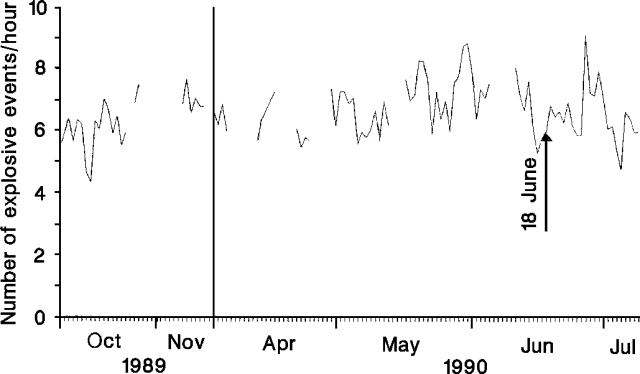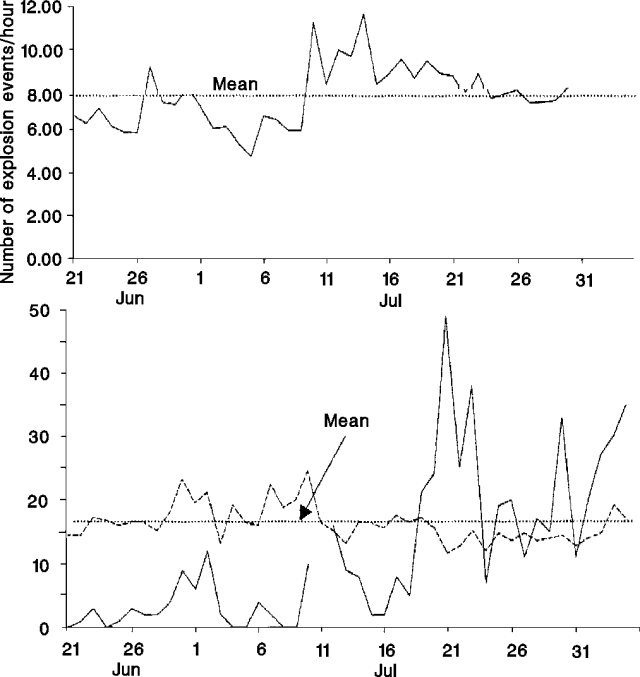Report on Stromboli (Italy) — August 1990
Bulletin of the Global Volcanism Network, vol. 15, no. 8 (August 1990)
Managing Editor: Lindsay McClelland.
Stromboli (Italy) Strong explosions; one crater filled by tephra
Please cite this report as:
Global Volcanism Program, 1990. Report on Stromboli (Italy) (McClelland, L., ed.). Bulletin of the Global Volcanism Network, 15:8. Smithsonian Institution. https://doi.org/10.5479/si.GVP.BGVN199008-211040
Stromboli
Italy
38.789°N, 15.213°E; summit elev. 924 m
All times are local (unless otherwise noted)
An automatic telemetering short-period seismic station was installed near the active craters in October 1989 to monitor explosive activity and volcanic tremor. During that month, "normal Strombolian" activity from Craters 1 and 3 produced ~160 explosive events/day (figure 5). During the second half of November, several events with peculiar waveforms were recorded over a 4-day period. Volcano guides (who cooperate with volcanologists by noting visible activity, as reported below) observed a new cone inside Crater 1 in December 1989, and another cone that showed explosive activity between craters 1 and 2 in February 1990. In March, small cones produced bluish vapor inside Crater 3; emissions were accompanied by dull rumbling.
 |
Figure 5. Average number of seismic events/hour recorded at Stromboli, October-November 1989 and April-July 1990. Arrow marks 18 June explosions. Courtesy of M. Riuscetti. |
During the end of May and the first half of June (28 and 30 May, and 3, 4, 11, 13, and 15 June) "normal" activity was observed at craters 1 and 3 with continuous explosions and ejection of incandescent material to 10-50 m height. Crater 2 was not active during this period. Morphologic changes to the new cones in Crater 1 were not evident.
At least four large explosions occurred on 18 June between 1700 and 1710. Ejecta fell onto the NW flank's Sciara del Fuoco and ash emission could be seen from S. Bartolo village on the NE side of the island. The wall between craters 2 and 3 collapsed. After this episode, explosive activity with ejection of small glowing blocks was observed at Crater 2 (on 19, 21, 24, 25, and 28 June, and 2 July) with almost continuous noisy gas emission (on 25 June, and 4, 7, and 9 July). Craters 1 and 3 were active, with ejection of glowing material to ~100-150 m height (on 24 and 26 June, and 1, 3, 4, 5, 7, and 9 July).
An increase in the number of low-energy explosion earthquakes occurred 9-16 July, while tremor amplitude decreased slightly. The number of events saturating the seismometer then increased sharply, while low-energy shocks dropped to near the long-term mean (figure 6). Ash and lapilli emissions were continuous from the three craters, with increases in ejecta height and emission frequency after 19 July. The strong eruptive activity declined after 26 July. Crater 2 had been completely filled by tephra, but included two active vents characterized by synchronous noisy explosions. Activity at Crater 3 was dominated by prolonged silent ash emissions. Continuous strong explosions from Crater 1 have been observed since 1 August.
Geological Summary. Spectacular incandescent nighttime explosions at Stromboli have long attracted visitors to the "Lighthouse of the Mediterranean" in the NE Aeolian Islands. This volcano has lent its name to the frequent mild explosive activity that has characterized its eruptions throughout much of historical time. The small island is the emergent summit of a volcano that grew in two main eruptive cycles, the last of which formed the western portion of the island. The Neostromboli eruptive period took place between about 13,000 and 5,000 years ago. The active summit vents are located at the head of the Sciara del Fuoco, a prominent scarp that formed about 5,000 years ago due to a series of slope failures which extends to below sea level. The modern volcano has been constructed within this scarp, which funnels pyroclastic ejecta and lava flows to the NW. Essentially continuous mild Strombolian explosions, sometimes accompanied by lava flows, have been recorded for more than a millennium.
Information Contacts: M. Riuscetti, Univ di Udine; volcano guides:Prospero Cultrera, Nino Aquilone, and Antonio Zerilli, Stromboli, Italy.


